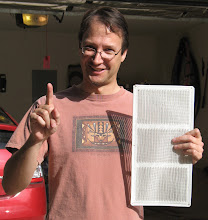Here is a graph of energy usage vs. Cooling Degree Days (CDD's, see previous posts for explanation) for 2005 and 2009. Since 2009 isn't over yet, I have substituted 2008 data for both November and December, but neither of those months is real significant for cooling costs.
Again, as in the previous post, the hysteresis of the system is quite apparent.
- As expected from personal experience, the 2009 loop extends almost 100 CDDs further to the right than the 2005 loop, indicating the record breaking HOT summer here.
- The curve for 2009, while showing some positive slope, looks almost unfazed by the increasing heat.

Including the numbers from our last post covering 2007, here are the final results of this analysis method:
2005 Slope: 2.8 kWh/CDD
2007 Slope: 1.1 kWh/CDD
2009 Slope: 0.84 kWh / CDD
So, by 2009, the effectiveness of my cooling system has increased again. Stated as "kWh of energy to cool 1 CDD", the effectiveness has gone up from:
(1/2.8)= 0.35 CDD per kWh expended to
(1/0.84)=1.19 CDD per kWh expended.
Finally: something meaningful to compare. Stated as simply as I can, based on linear best-fit analysis to remove weather dependencies:
The energy cost of cooling my home 1 degree has dropped 70% due to my efforts.


No comments:
Post a Comment